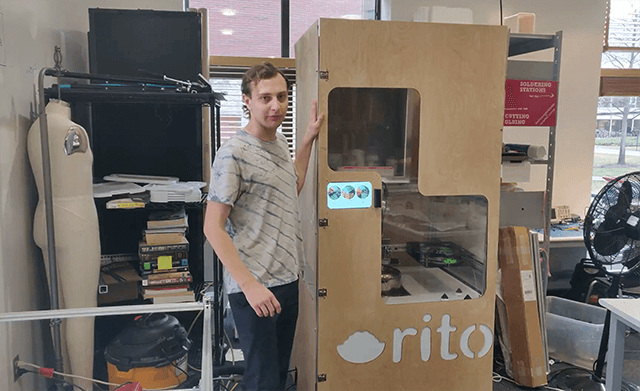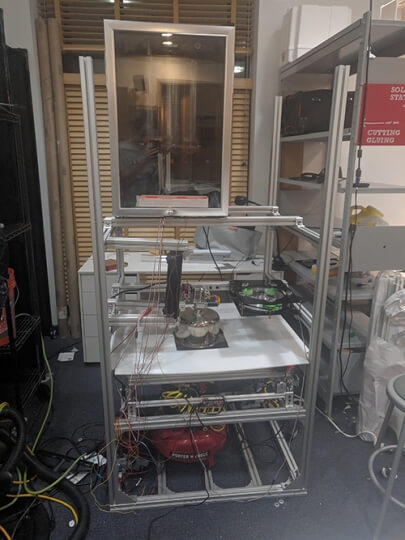News
This robotic vending machine built by Nestor Tkachenko can make a fresh burrito bowl in a matter of minutes. (Photo provided by Nestor Tkachenko)
When lunchtime rolls around, many office workers face limited options. Only 12 percent of employers offer on-site cafeterias, according to the Society for Human Resource Management, and with many companies discouraging long out-of-office lunches, employees are often forced to brown bag it at their desks.
Robots could rescue workers from banal bologna and humdrum hummus, according to Nestor Tkachenko, A.B. ’21, a physics and computer science concentrator at the Harvard John A. Paulson School of Engineering and Applied Sciences. He has built a robotic burrito bowl vending machine that can craft a fresh meal in a matter of minutes.
“It doesn’t make sense for a Chipotle to open in an office building because they’d need to sell hundreds of meals a day to break even,” he said. “But if you had a robot that could produce the same thing, like a burrito bowl, and you’d only have to restock it once per day, you’d only need to sell five or 10 bowls to break even. That allows you to penetrate this whole new market.”
Which is exactly what Tkachenko has set out to do.
With $4,000 in funding from the school, he built a vending machine that sells custom burrito bowls for $8.50. The funding came from the NECTAR program, established at SEAS in 2012, to support extracurricular projects in engineering and applied sciences.
A hungry patron uses a tablet to select items to customize their bowl, such as beans, chipotle mayo, or guacamole, and swipes a credit card. In three to four minutes, lunch is ready.
Inside the machine, that transaction kicks off a flurry of activity.
The biggest challenge was psychological—when I first envisioned it, it just felt so impossible to build because there are so many different components.
A refrigeration unit on top of the robot dispenses pre-cooked chicken and other cold ingredients into a revolving, paramagnetic bowl, which is heated by an induction cooker that stirs the items as they cook.
That cooker then pivots and drops the heated ingredients into a plastic bowl, which moves under a dispensing unit where items like beans and guacamole are added before the finished meal is served up to the user.
“The biggest challenge was psychological—when I first envisioned it, it just felt so impossible to build because there are so many different components,” he said. “But over time, it all aligned and worked out. I took it step by step, and it actually wasn’t as difficult as I thought it would be.”
A look inside the burrito bowl-making robotic vending machine (Photo provided by Nestor Tkachenko)
Getting eight rotating containers of food to mesh correctly proved to be one of the steepest challenges, Tkachenko said. He solved that problem by adding a joystick to the refrigeration unit that detects when a container is in the right position so it stops rotating.
Keeping the robot clean is another hurdle. Tkachenko initially intended to use a water sprayer to clean the machine, but ensuring proper drainage was too difficult. Instead, he incorporated a non-stick pan and a compressor that blows air to blast away any stuck pieces of food. The entire system is hand cleaned each day when the refrigerated ingredients are replaced.
For now, Tkachenko is replacing the food himself. He orders chipotle mayo, beans, and salsa online, and has found a unique brand of microwave rice that doesn’t stick to the container. Each day (until the coronavirus forced the temporary end of residential student housing), he would cut up cooked chicken from the Harvard University Dining Services grill.
But he sees this as just the very beginning.
“The vision is for much more than just burrito bowls,” he said. “The vision is that, one day, you can come down to the lobby of your office building and you can choose between a robot that makes fresh pizza and a robot that makes fresh salad and a robot that makes fresh burrito bowls. You could have that kind of selection in any office building.”
Tkachenko is using his prototype as a proof-of-concept as he seeks funding and a partnership with a manufacturing firm to help him scale up production.
Looking to the future, he plans to refine the design to use microwave infrared heaters, which would eliminate any danger of cross-contamination and streamline the lunch-making process. And he’d like to offer even more options for hungry office workers—with a few tweaks, the robot could also make poke bowls, salads, and even pasta.
His goal is to have a dozen lunch-making robots in Boston-area hospitals within the next two years.
While it is a lofty vision, Tkachenko has learned not to be daunted by a seemingly impossible problem.
“No project is too ambitious,” he said. “This is a huge, promising space. Whether or not my project is successful, I have no doubt that over the next decade we are going to see a bunch of these food robots popping up. I’m very excited to be able to work in this space. I think it is going to be a huge game-changer in the coming years.”
Watch Nestor Tkachenko's burrito bowl-making robotic vending machine in action.
Topics: Computer Science, Cooking, Entrepreneurship, Robotics
Cutting-edge science delivered direct to your inbox.
Join the Harvard SEAS mailing list.
Press Contact
Adam Zewe | 617-496-5878 | azewe@seas.harvard.edu




